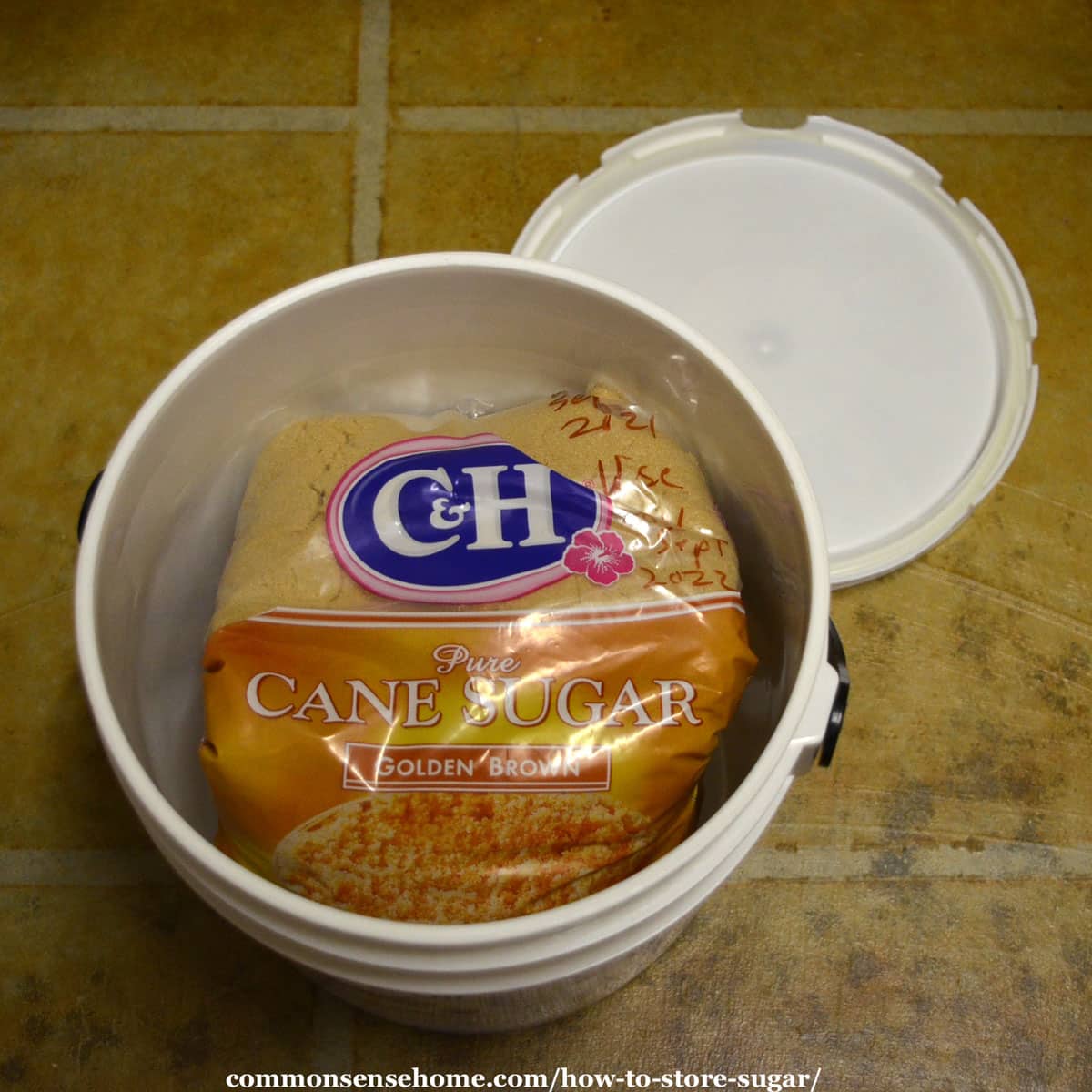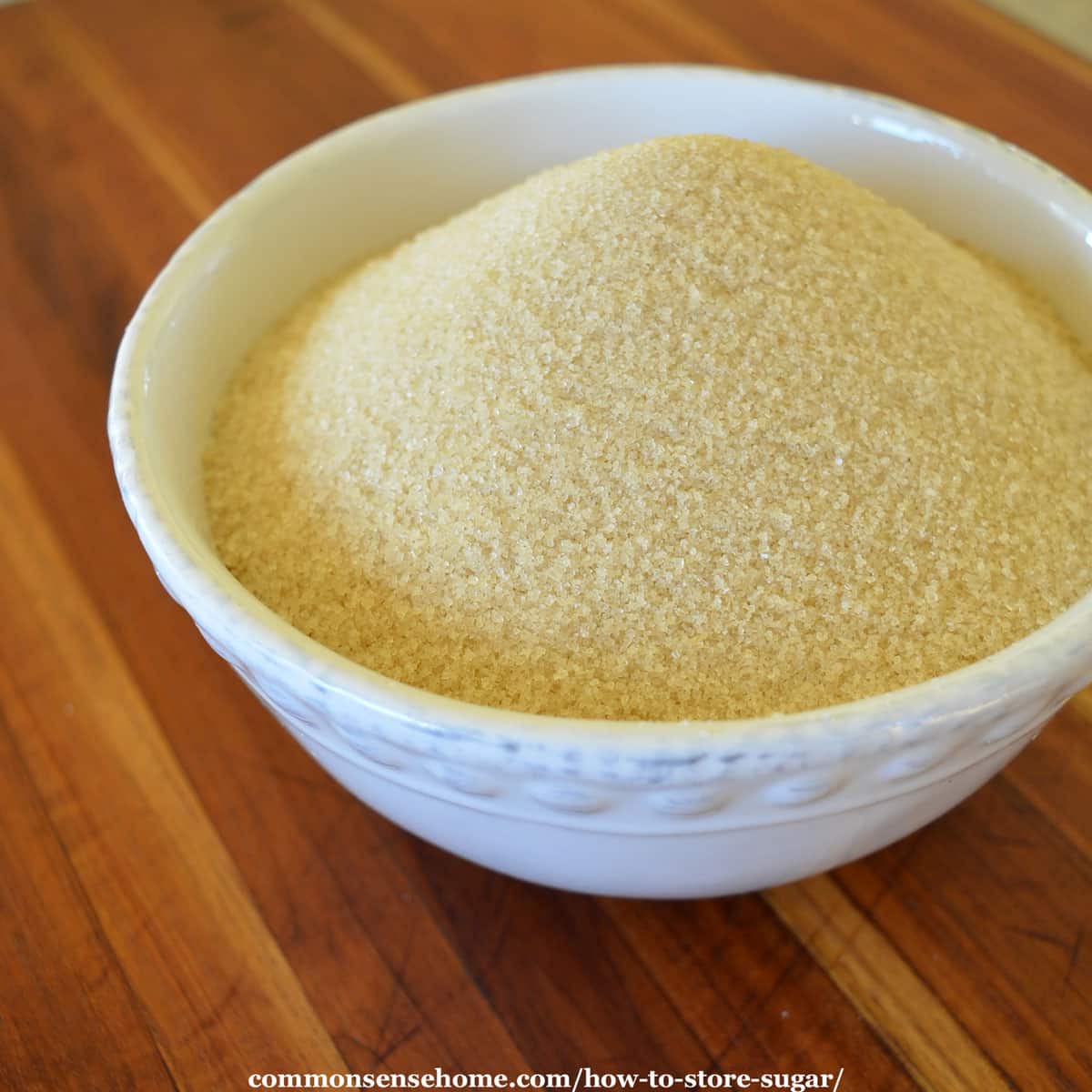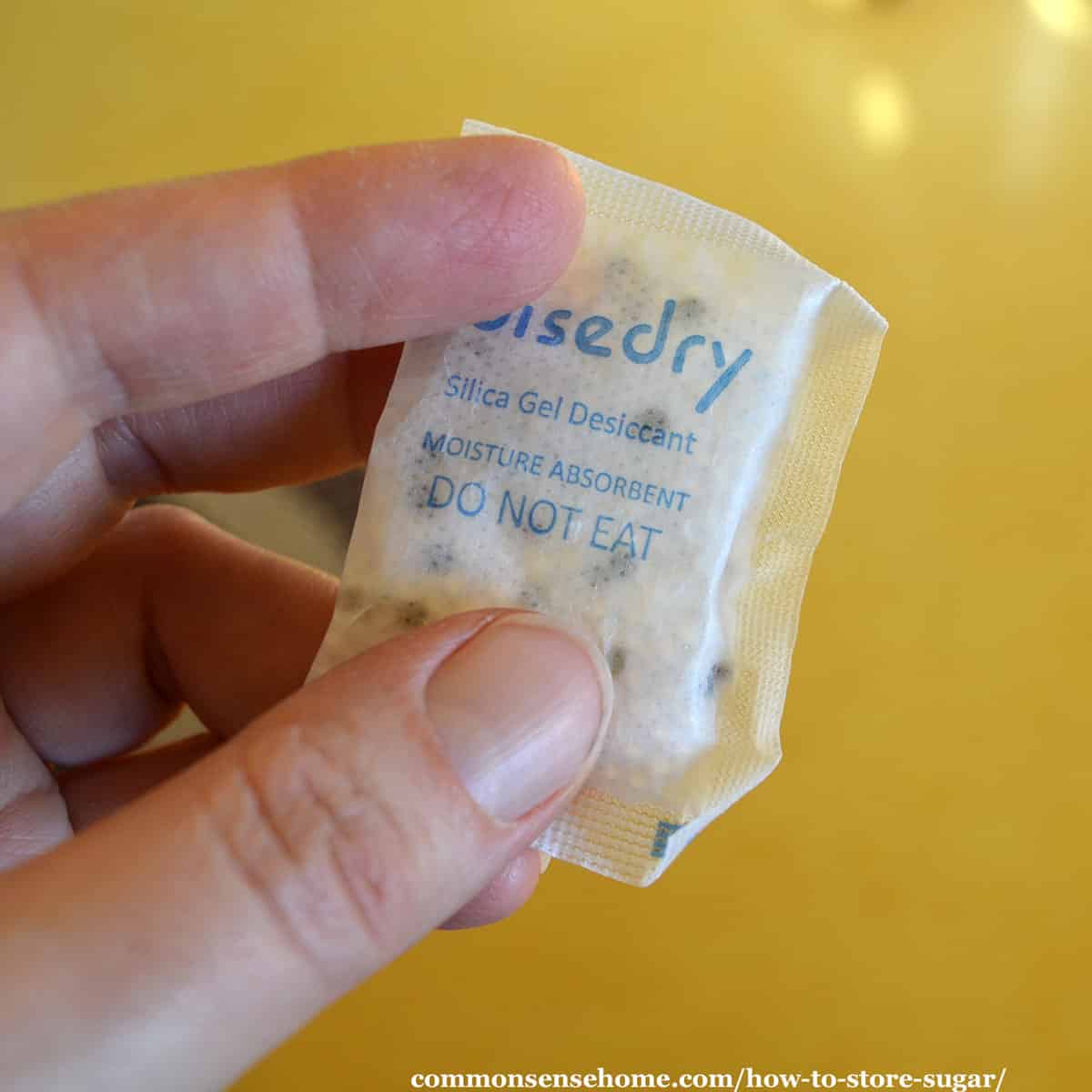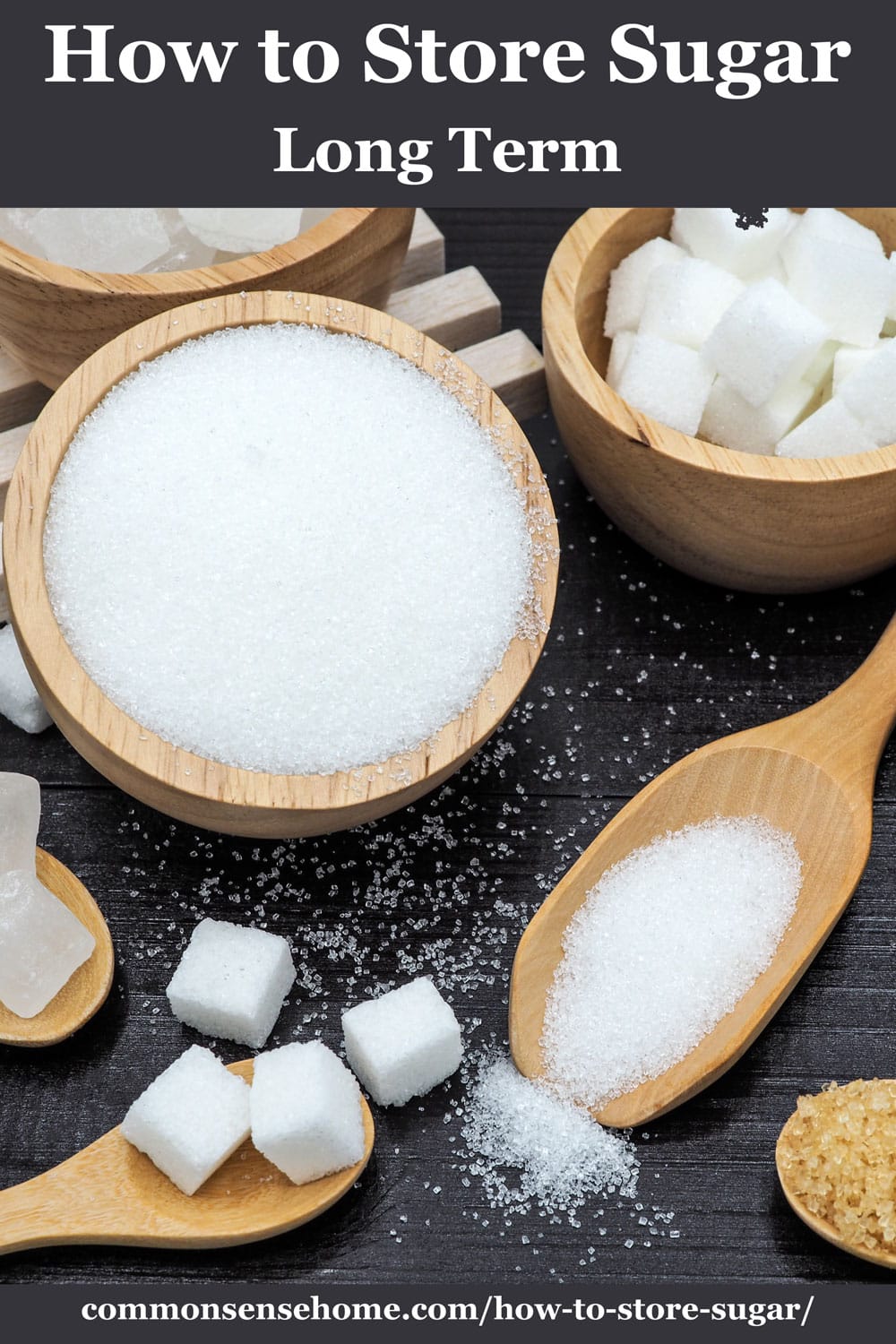How to Store Sugar Long Term
This post may contain affiliate links. Read my full disclosure here.
With all the bad press about sugar, why would you want to learn how to store sugar, long term or otherwise? Sugar acts as a preservative, adds variety to recipes, and is a fairly inexpensive calorie source. You can also use it for wound care, as I’ll explain in a bit.
We’ll share how to store sugar long term – granulated, brown, and powdered – with tips for quality and mistakes to avoid.

Types of Sugar
There are many other types of sugar and sugar syrups. For long term storage, refined sugar works best. Granulated white sugar made with beets or sugar cane lasts for years in an airtight container.
Powdered sugar is white sugar that’s been pulverized into a fine powder. It’s often mixed with anti-caking agents like cornstarch or tricalcium phosphate to prevent clumping.
Brown sugar is white sugar with molasses added back in. It’s not quite as good for long term storage because it tends to turn into a brick. You can pulse one cup white sugar in a food processor with one tablespoon of molasses to make brown sugar at home.
There are many other sugars like turbinado, demerara, coconut sugar, and more. For best quality, use less refined sugars like coconut sugar and maple sugar within two years.
See also:
How to Store White Sugar and Powdered Sugar
Sugar should be stored in an airtight container. Keep sugar in a dry location, away from strong odors. Avoid the refrigerator, which has a lot of moisture. Freezer storage is okay, but not needed.
If you live in a humid area, don’t store granulated sugar (white sugar) in the paper bag from the grocery store. It will absorb moisture and get hard and lumpy. While it’s still safe to use, it’s a hassle to measure.
Storing powdered sugar (confectioner’s sugar) in the plastic bags from the store is fine. That said, if you want to keep it a long time, place those bags inside a sturdier airtight container. Bugs and rodents can easily chew through thin plastic.

How to Store Brown Sugar
White granulated sugar, light brown and dark brown sugar all have an indefinite shelf life. The problem is that with brown sugar, over time it can dry out and get very hard. (This is the opposite of granulated sugar, where it clumps as it absorbs moisture.)
To keep your brown sugar soft and easy to use, opt for an air tight container. This time, you want to trap the moisture in the sugar instead of keeping it out. Avoid the refrigerator, as the molasses in the sugar gets stiff in cold temperatures.
If you’ll use the sugar within a year, the original plastic package should be fine. For longer storage, repack into a canning jar or other airtight container.

Storage Containers
How long do you want to store sugar, and how much do you want to store?
For daily use, I pour a 10 pound bag of granulated into a resealable plastic storage container. Brown sugar and powdered sugar stay in their one pound plastic bags.
For longer storage, we opt for sturdier containers. Remember, all sugar stores best in an airtight container away from strong odors.
You can buy sugar in #10 cans, but 25 or 50 pound bags tend to be cheaper. We buy 50 pounds and repack into Mylar bags holding 10 pounds each, and pack the Mylar into five gallon buckets. Canning jars or other jars with good seals work well for smaller amounts of sugar.
Be careful vacuum sealing sugar in canning jars, as the sugar can get sucked into the sealer.
If you like, you can vacuum seal an entire bag of sugar into a custom sized vacuum sealer bag. A vacuum sealed bag of sugar will keep a couple of years, but eventually absorbs moisture and turns into a brick.
How much Sugar should I Store?
Refined sugar lasts indefinitely, so you can store whatever you care to stock. For light use, start with 10 pounds per adult. If you are into preserving sweet food or wine making, a larger amount of sugar is better.
Even if you don’t eat regularly eat sugar, it’s a good idea to keep at least a small amount on hand. Sugar is hygroscopic, which means it absorbs water/liquid. This property comes in handy for preserving food, keeping food moist and fresh, and for treating some injuries.
Before the advent of antibiotics, sugar was commonly used to treat wounds. Now with the rise of antibiotic resistant bacteria, it’s getting attention again.
A recent study showed that granulated sugar inhibited bacterial growth. Plain granulated sugar worked better than demerara sugar. The sugar helped even old wounds that refused to heal with other treatments.
Would you like to save this?
My neighbor contacted me to borrow some sugar when she had a goat prolapse. After applying a sugar poultice to the goat’s back end, the prolapse shrunk and healed completely.
See also “Honey as Medicine“.

Do you need oxygen absorbers to store sugar long term?
No, you don’t need oxygen absorbers for sugar storage. Adding them may turn your sugar into a brick.
Do you need a moisture absorber to store sugar?
If you store your sugar in an airtight container, you don’t need a moisture absorber. We add them to long term storage storage containers of granulated sugar, but it’s not strictly necessary.

Does storage temperature affect shelf life of sugar?
Brown sugar and powdered sugar last best stored in a cool dry location.
Granulated sugar is not temperature sensitive. Any temperature below 300℉ (148℃) is safe. It can be stored in hot or cold areas, including a garage or outbuilding. As long as you have it in tightly sealed container, it can go pretty much anywhere.
How to Soften Brown Sugar
If by chance the brown sugar you bought is hard, or you forget about it in the back of the pantry and it turns into a brick, there are several ways to soften it.
With brown sugar, it gets hard if it gets cold, or if it dries out. To make brown sugar soft again, we add moisture or warmth – or both.
If you have time to wait for the sugar to get soft:
Place the sugar in a container. Set a damp paper towel or damp cloth in the container on top of the sugar. Cover tightly and let rest overnight so the sugar absorbs moisture from the towel.
For quicker results, place the sugar in a microwave safe container with a damp towel. Cover and heat in short bursts (20-30 seconds), mixing between heating to check softness.
Some people add an apple, or a slice of bread, or a damp ceramic disk to add moisture, but using a towel with clean water is simple and doesn’t contaminate your sugar. If you don’t have a microwave, you can sprinkle the sugar with water and heat it gently on the stove top.
How to Soften White Sugar
White sugar clumps when it absorbs moisture, so we need to dry it out.
If you have a big dehydrator like the Excalibur, you can load your sugar in and dry for an hour or two. Another option is to heat the oven to low (around 200 ℉), turn it off, and then let the sugar rest inside for an hour or two.
Once the sugar has a chance to dry, loosen the surface with a fork or kitchen mallet.



Where do you get the white buckets shown in your blog post?
You can sometimes find them free or cheap at bakeries or other food prep locations, as they get ingredients in them. They may have smaller sizes, like 1 gallon or 2 gallon, or up to the larger 5 gallon size. Typically the free ones are still covered in whatever they stored, like frosting or fruit filling, so you have to wash them.
You can also buy them at amazon or other retailers. I do suggest using food grade buckets so they don’t leach anything dangerous into your food storage. You can get ones with screw on lids like these, or ones with shove on lids like these. If you get the shove on lids, you’ll want a lid opener to pry them off. It also takes some muscle to pound the lids on and to pry them off.
The ones with screw on lids are more expensive, but much easier to use, especially if you want to regularly open and close the bucket. We have some of both, and I admit I generally ask my sons to get into the ones with the clamp on/shove on lids. They can be tough to pry open. Either type will get the job done.
my Mom always put a slice of bread in top of sugar,even brown sugar to keep from getting hard. you can also buy those brown porous ceramic bears you put in with sugar
We were already storing regular white sugar in plastic bags, and it still turned in to bricks.
Plastic is still somewhat porous, so foods stored in it will absorb moisture over time. Note that for longer storage we seal in Mylar inside of a bucket. We do not keep anything in plastic only for long term storage.
I have been able to store brown sugar for several years with good success by just storing it in a gallon glass jar with several large marshmallows added to the top of the jar. Quick and easy. Blessings.
The airtight seal is the most important part for long term storage, but given that marshmallows are mostly sugar themselves and won’t shed crumbs, I think they’re a much better topper than many other things I’ve seen suggested.